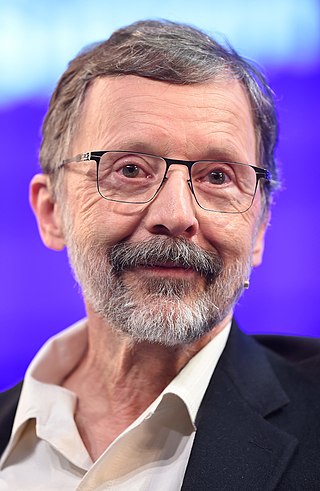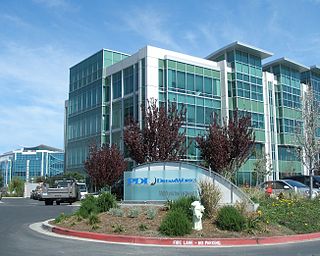
Computer animation is the process used for digitally generating moving images. The more general term computer-generated imagery (CGI) encompasses both still images and moving images, while computer animation only refers to moving images. Modern computer animation usually uses 3D computer graphics.

SIGGRAPH is an annual conference centered around computer graphics organized by ACM, starting in 1974. The main conference is held in North America; SIGGRAPH Asia, a second conference held annually, has been held since 2008 in countries throughout Asia.

Edwin Earl Catmull is an American computer scientist and animator who served as the co-founder of Pixar and the President of Walt Disney Animation Studios. He has been honored for his contributions to 3D computer graphics, including the 2019 ACM Turing Award.
This is a chronological list of films and television programs that have been recognized as being pioneering in their use of computer animation.

ACM SIGGRAPH is the international Association for Computing Machinery's Special Interest Group on Computer Graphics and Interactive Techniques based in New York. It was founded in 1969 by Andy van Dam.
Donna J. Cox is an American artist and scientist, Michael Aiken Endowed Chair; Professor of Art + Design; Director, Advanced Visualization Lab at the University of Illinois at Urbana-Champaign (UIUC); Director, Visualization and Experimental Technologies at National Center for Supercomputing Applications (NCSA); and Director, edream. She is a recognized pioneer in computer art and scientific visualization, specifically cinematic scientific visualization.

James F. Blinn is an American computer scientist who first became widely known for his work as a computer graphics expert at NASA's Jet Propulsion Laboratory (JPL), particularly his work on the pre-encounter animations for the Voyager project, his work on the 1980 Carl Sagan documentary series Cosmos, and the research of the Blinn–Phong shading model.

Loren C. Carpenter is a computer graphics researcher and developer.
Lillian F. Schwartz is an American artist considered a pioneer of computer-mediated art and one of the first artists notable for basing almost her entire oeuvre on computational media. Many of her ground-breaking projects were done in the 1960s and 1970s, well before the desktop computer revolution made computer hardware and software widely available to artists.

Pacific Data Images (PDI) was an American visual effects and computer animation production company based in Redwood City, California, that was bought by DreamWorks SKG in 2000. It was renamed PDI/DreamWorks and was owned by DreamWorks Animation.

Virtual cinematography is the set of cinematographic techniques performed in a computer graphics environment. It includes a wide variety of subjects like photographing real objects, often with stereo or multi-camera setup, for the purpose of recreating them as three-dimensional objects and algorithms for the automated creation of real and simulated camera angles. Virtual cinematography can be used to shoot scenes from otherwise impossible camera angles, create the photography of animated films, and manipulate the appearance of computer-generated effects.
Thomas Albert "Tom" DeFanti is an American computer graphics researcher and pioneer. His work has ranged from early computer animation, to scientific visualization, virtual reality, and grid computing. He is a distinguished professor of Computer Science at the University of Illinois at Chicago, and a research scientist at the California Institute for Telecommunications and Information Technology (Calit2).

Patrick M. Hanrahan is an American computer graphics researcher, the Canon USA Professor of Computer Science and Electrical Engineering in the Computer Graphics Laboratory at Stanford University. His research focuses on rendering algorithms, graphics processing units, as well as scientific illustration and visualization. He has received numerous awards, including the 2019 Turing Award.

Fluid animation refers to computer graphics techniques for generating realistic animations of fluids such as water and smoke. Fluid animations are typically focused on emulating the qualitative visual behavior of a fluid, with less emphasis placed on rigorously correct physical results, although they often still rely on approximate solutions to the Euler equations or Navier–Stokes equations that govern real fluid physics. Fluid animation can be performed with different levels of complexity, ranging from time-consuming, high-quality animations for films, or visual effects, to simple and fast animations for real-time animations like computer games.

Michael Arias is an American-born filmmaker active primarily in Japan.
Teresa Cheng is an animation producer specifically skilled in computer graphics and most famously known for her work on Shrek Forever After, Madagascar, Batman & Robin, and True Lies. She has worked with major agencies such as Warner Brothers Studios, DreamWorks, assumed the role of general manager for Lucasfilm Animation, and most recently has become chair of the John C. Hench Division of Animation and Digital Arts at the USC School of Cinematic Arts.

Craig Barron is an American visual effects artist and creative director at Magnopus, a media company that produces visual development and virtual production services for motion pictures, television, museums and multimedia platforms.
Jason Donati is an animator, educator, and author noted for his animated independent film work, professional career as a 3D visualization artist, and academic authorship including Exploring Digital cinematography, published by Cengage Learning.
The history of computer animation began as early as the 1940s and 1950s, when people began to experiment with computer graphics – most notably by John Whitney. It was only by the early 1960s when digital computers had become widely established, that new avenues for innovative computer graphics blossomed. Initially, uses were mainly for scientific, engineering and other research purposes, but artistic experimentation began to make its appearance by the mid-1960s – most notably by Dr. Thomas Calvert. By the mid-1970s, many such efforts were beginning to enter into public media. Much computer graphics at this time involved 2-D imagery, though increasingly as computer power improved, efforts to achieve 3-D realism became the emphasis. By the late 1980s, photo-realistic 3-D was beginning to appear in film movies, and by mid-1990s had developed to the point where 3-D animation could be used for entire feature film production.

Hao Li is a computer scientist, innovator, and entrepreneur from Germany, working in the fields of computer graphics and computer vision. He is co-founder and CEO of Pinscreen, Inc, as well as associate professor of computer vision at the Mohamed Bin Zayed University of Artificial Intelligence (MBZUAI). He was previously a Distinguished Fellow at the University of California, Berkeley, an associate professor of computer science at the University of Southern California, and former director of the Vision and Graphics Lab at the USC Institute for Creative Technologies. He was also a visiting professor at Weta Digital and a research lead at Industrial Light & Magic / Lucasfilm.












